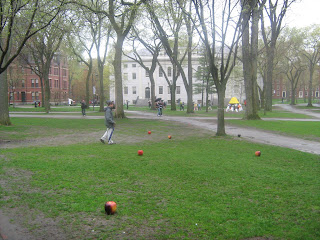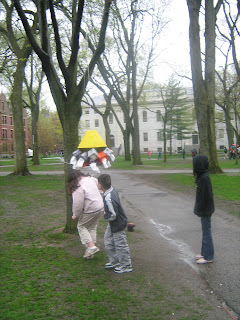
"Brown paper packages tied up with strings /
These are a few of my favorite things..." -The Sound of Music
The thesis of the song "My Favorite Things," of course, is that thinking of life's little blessings, things that make one happy, might take the edge of any unpleasantness at hand and actually remind us to be grateful.
Let's see if it works.
This week has been a bit of a roller coaster.
Earlier this week I walked in to help a couple of colleagues with a patient who was hypotensive with septic shock on the table and subsequently got a lot of appreciation from the people involved with the case.
Then a surgeon at one of my hospitals complained I had insulted her after I told her in a pretty determined way that her patient was not an appropriate candidate for surgery at that particular hospital in the current state the patient was in.
Then at another hospital a patient's family told me I was their favorite doctor during their whole ordeal at the place and that I had really made a difference in a way that reduced their anxiety about their loved one's care.
Then I got into a disagreement with someone in my anesthesia group (now smoothed-over).
At some point I had some good news, about an essay I wrote getting included in an anthology due to be published this fall.
Then yesterday a CRNA I was working with had trouble intubating her patient and I stepped in to try, certain that if she, who had been practicing anesthesia for as long as I'd been alive and had actually helped train some of my colleagues, couldn't get the airway, then I certainly didn't have a better chance. Relief replaced alarm when the tube went into the right place. But after that the O.R. kept running till midnight. Again.
Now I'm a little tired. But I'm also on call. As luck would have it the weather's supposed to be glorious this whole holiday weekend.
Thus I'm trying to think of my favorite things, so that
"when the call bites /
when O.B. stings /
when I'm feeling sad /
I simply remember my favorite things /
and then I don't feel so bad..."
Here they are, then, like a giant meme. I've grouped my "things" into four sections: general, books, movies/music/performing arts, and food. Thanks to Katy who writes the blog
Funny Girl for getting me thinking about the book section!
My Favorite Things
Accent: Scottish, Australian
Animal: Alpaca
Artist: Norman Rockwell
Bird: Snowy owl
Building: The National Shrine of the Immaculate Conception in Washington, D.C.; Chartres Cathedral
Cities: Florence; Paris; Boston; London
Color: Blue
Country: France; the U.S.
Experience: hearing a brass concert at Gore Place, or Dixieland at Cate Park, on a picnic blanket w/ husband and kids; a great, relaxing massage
Flower: rose (red or white)
"Foreign" accent: Scottish
Historical person: hmm...gotta come back to that one
Hobby: blogging! and of course, oboe
Holiday: Christmas
Invention: writing; indoor plumbing; warm showers
Language: to hear – French, Russian; to express ideas – English
Make-up: MAC
Outfit: comfortable blue jeans, tank top, and button-down work shirt
Painting: Hilltop Farm in Winter by Maxfield Parrish
Pen: Sanford Uniball Grip Fine (micro tip)
Place: our cabin in New Hampshire
Saint: René Goupil
School: Stone Ridge School of the Sacred Heart; Harvard College
School subject: English, French, social studies
Scripture passage: Romans 8: 38-39
Sport to do: if dance could be considered a sport, I’d say that
Sport to watch: Men’s gymnastics
State: Vermont
Store: Borders
Time period: 19th century
Thing-to-do from a to-do list: Wrap Christmas presents
Books / Literary Favorites
Fictional characters: Atticus Finch, Sherlock Holmes, Elizabeth Proctor
Magazine/periodical: Image Journal; O
Nonfiction book: On Writing Well by William Zinsser
Novels for adults: To Kill a Mockingbird by Harper Lee; The Help by Kathryn Stockett; Prodigal Summer by Barbara Kingsolver; The Curious Incident of the Dog in the Night-time by Mark Haddon; Gilead by Marilynne Robinson; Lying Awake by Mark Salzman
Novel for children: Tuck Everlasting by Natalie Babbitt
Novel for young adults: A Ring of Endless Light by Madeleine L’Engle; Two from Galilee by Marjorie Holmes
Picture book for children: The Christmas Miracle of Jonathan Toomey by Susan Wojciekowski and The Fourth Wise Man by Summers; Hooway for Wodney Wat by Helen Lester
Poem: Barter by Sara Teasdale, Stammerer on Scree by Owen Sheers
Poet(s): Herbert, Hopkins, Donne
Short story: The Expert on God by John L’Heureux and Roman Fever by Edith Wharton
Movies, Music, & Performing Arts Faves
Action movie: Independence Day; King Arthur; Troy; Kingdom of Heaven
Actor: Edward Norton, Hugh Jackman
Actress: Scarlett Johansson, Reese Witherspoon, Anna Popplewell
Black-and-white movie: To Kill a Mockingbird; also, Roman Holiday & Casablanca
Cartoon: Pinky & the Brain
Comedy (movie): By the Light of the Silvery Moon; While You Were Sleeping; Elf; The Trouble with Angels; Little Miss Sunshine
Drama (movie): The Mission; The Illusionist
Movie moment: dictation scene in Amadeus
Musicals: The Secret Garden, Jesus Christ Superstar, Annie, Chess, Les Miz, Miss Saigon, Wicked, The Sound of Music, Legally Blonde
Period flick: A Christmas Carol starring George C. Scott; A Room with a View
Scary movie: The Exorcism of Emily Rose
Sci Fi movie: Independence Day
Screen kiss: Jeremy Irons' in And Now Ladies and Gentlemen
T.V. Show: Bones; The West Wing; Star Trek: the Next Generation; Star Trek: Voyager; Boomtown
Cellist: Rufus Cappadocia
Choral piece: Os justi by Bruckner; There is No Rose by Stroope
Christmas carol: In Dulci Jubilo; Ding Dong Merrily on High; O Come, O Come Emmanuel; O Come All Ye Faithful
Concerto: Concierto de Aranjuez by Rodrigo; Piano Concerto #17 in D by Mozart
Oboe piece: Concerto for Oboe and Strings by Ralph Vaughan Williams
Oboist: Celia Nicklin
Orchestral work(s): Appalachian Spring, Fanfare for the Common Man, and Rodeo by Copland; millennium parade music from Epcot Center; 4th Movement of Tchaikovsky's Suite #4
Piano piece: Prelude in G minor by Rachmaninoff; Sonata in B minor by Liszt
Pop Song: Who Knew
Violinist: Gil Shaham
Religious song: By the Rivers of Babylon by Marty Haugen
Ballet, classical: Sleeping Beauty
Ballet, contemporary: In the Middle Somewhat Elevated by William Forsythe
Ballet, overall: Revelations by Alvin Ailey
Dance company: Alvin Ailey Dance Company
Sung play, not exactly a musical: Missionaries by Elizabeth Swados
Opera: Amahl and the Night Visitors by Giancarlo Menotti; Der Rosenkavalier; La Boheme; Tosca
Operetta: Die Fledermaus
Play, comic: Noises Off by Michael Frayn and You Can't Take It With You by George S. Kaufman and Moss Hart (esp. the Jason Robards production that aired on TV in the'80's)
Play, dramatic: The Crucible by Arthur Miller; The Arabian Nights by Mary Zimmerman; Proof; Copenhagen; Amadeus; Equus
Food Favorites
Appetizer: baked brie en croute with a bit of a fruit-&-nut layer
Beverage, cold: water
Beverage, hot: Viennese Chocolate Café coffee by International Foods
Breakfast: coffee & croissant, just like Dr. Crusher on Star Trek: the Next Generation; cereal & berries with a little fromage blanc or Greek-style yogurt; tartines; Tita M’s ensaymadas
Cake: opera gateau; the Philippine cake known as sans rival; sachertorte; one at Whole Foods that has little pink flowers on it and beige buttercream icing
Cheese: Bailey Hazen Blue; Stichelton; Reypenaer; Comte; Boursin
Chocolate: Godiva; Toblerone (milk > dark > white)
Cookie:

chocolate chip cookies from the now-closed “David’s Cookies” chain in New York (the online version’s not the same, somehow, and you miss out on the amazing aroma of fresh-out-of-the-oven, warm, chocolate chunk cookies at the bakeshop…); also, Taiwanese "ChocoRoll: pudding flavor" cylindral cookies covered with milk chocolate
Dessert: crème brûlée
Dip: Whole Foods' Smoky Harissa Hummus; fresh guacamole
Fruit: Philippine mango; blackberry
Hors d’oeuvres: bacon-wrapped scallops; crab rangoon
Ice cream: Oreo ice cream by J.P. Licks, slathered with hot fudge of course; Ginger Snap & Molasses ice cream at Rancatore's; Tres Leches by Haagen-Dasz
Main Course: really good Thai food
Meat/Fish: teriyaki beef skewers; great prime rib; grilled trout
Merienda: Philippine mangoes with bagoong; croissants; churros con chocolate
Pasta: butternut squash ravioli with a light sage-infused or maple-cream sauce
Rice dish: wild mushroom/porcini/morel risotto; Philippine garlic fried rice
Salad: my cousin Gaita’s Insalata Pacifica at her restaurant, Cibo; Thai Crunch Salad or Field Greens Salad at CPK; Cobb salad with sherry vinaigrette at Not Your Average Joe’s
Side order: the now-defunct Tony Roma’s onion ring loaf; sauteed onions and potatoes seasoned with a little salt and pepper; brown or white rice
Sidewalk snack: French crêpes
Soup: lobster bisque with lemon grass and coconut milk at Top of the Hub in Boston
Really, really, really bad, eat-it-only-once-a-year-in-small-servings type of junk food: Barbecue-flavored Doritos (I think they stopped making these…thank goodness…)
Really, really, really bad, eat-it-only-once-a-year-in-small-servings type of sweet food: chocolate-frosted Krispy Kreme doughnuts; cupcakes
Vegetable: green bean, I guess
I do feel a little better. I think I'll go have a cupcake...
 Today I went to a lovely baby shower during which we guests got to play some cute, enjoyable games, including "The Clothespin Game" and a scratch-and-sniff one called "Who Smells the Stinky Doo?" My favorite game (of course) was one called "Itty Bitty Baby Parts" (photo credit: http://www.babyshowerstuff.com/), which involved matching each of twelve numbered ultrasound images to an item on a list of anatomical parts we got at the beginning of the game. I didn't think I had an unfair advantage, because I skipped the radiology elective my senior year in medical school, and ultrasounds always look like unintelligible, fuzzy, gray stuff to me, but I ended up winning with a score of 10 correct out of 12 (uh...I kinda got the belly button mixed up with something else...)!
Today I went to a lovely baby shower during which we guests got to play some cute, enjoyable games, including "The Clothespin Game" and a scratch-and-sniff one called "Who Smells the Stinky Doo?" My favorite game (of course) was one called "Itty Bitty Baby Parts" (photo credit: http://www.babyshowerstuff.com/), which involved matching each of twelve numbered ultrasound images to an item on a list of anatomical parts we got at the beginning of the game. I didn't think I had an unfair advantage, because I skipped the radiology elective my senior year in medical school, and ultrasounds always look like unintelligible, fuzzy, gray stuff to me, but I ended up winning with a score of 10 correct out of 12 (uh...I kinda got the belly button mixed up with something else...)! there was at least one anatomy exam during which we had to file silently past tagged body parts and answer questions about the part in question. Sometimes the task was simply to identify it (Wait - what is that arrow pointing to? Just looks like a wad of tissue to me...); other times we had to describe something more detailed, like the path it took from point A to point B in the body, or its physiologic role, or some key molecular mechanism involved in its function or in diseases that marred its function.
there was at least one anatomy exam during which we had to file silently past tagged body parts and answer questions about the part in question. Sometimes the task was simply to identify it (Wait - what is that arrow pointing to? Just looks like a wad of tissue to me...); other times we had to describe something more detailed, like the path it took from point A to point B in the body, or its physiologic role, or some key molecular mechanism involved in its function or in diseases that marred its function.  there was at least one anatomy exam during which we had to file silently past tagged body parts and answer questions about the part in question. Sometimes the task was simply to identify it (Wait - what is that arrow pointing to? Just looks like a wad of tissue to me...); other times we had to describe something more detailed, like the path it took from point A to point B in the body, or its physiologic role, or some key molecular mechanism involved in its function or in diseases that marred its function.
there was at least one anatomy exam during which we had to file silently past tagged body parts and answer questions about the part in question. Sometimes the task was simply to identify it (Wait - what is that arrow pointing to? Just looks like a wad of tissue to me...); other times we had to describe something more detailed, like the path it took from point A to point B in the body, or its physiologic role, or some key molecular mechanism involved in its function or in diseases that marred its function.  It's amazing to me how much we can infer about people just from the ghostly markings of a chest x-ray - their disease process, their body type, sometimes particular stories about their lives. And yes, there are some astonishing x-rays - foreign objects in places you wouldn't expect them to be...
It's amazing to me how much we can infer about people just from the ghostly markings of a chest x-ray - their disease process, their body type, sometimes particular stories about their lives. And yes, there are some astonishing x-rays - foreign objects in places you wouldn't expect them to be... It's amazing to me how much we can infer about people just from the ghostly markings of a chest x-ray - their disease process, their body type, sometimes particular stories about their lives. And yes, there are some astonishing x-rays - foreign objects in places you wouldn't expect them to be...
It's amazing to me how much we can infer about people just from the ghostly markings of a chest x-ray - their disease process, their body type, sometimes particular stories about their lives. And yes, there are some astonishing x-rays - foreign objects in places you wouldn't expect them to be...

 Perhaps that pleasure in making sense of something, of things clicking into place, of solving a mystery or deepening comprehension, is more primal than we realize, with roots in our ancient histories. In people looking at the sky and making sense of the stars. In babies, brand new to the world, recognizing their parents' faces at last.
Perhaps that pleasure in making sense of something, of things clicking into place, of solving a mystery or deepening comprehension, is more primal than we realize, with roots in our ancient histories. In people looking at the sky and making sense of the stars. In babies, brand new to the world, recognizing their parents' faces at last. Perhaps that pleasure in making sense of something, of things clicking into place, of solving a mystery or deepening comprehension, is more primal than we realize, with roots in our ancient histories. In people looking at the sky and making sense of the stars. In babies, brand new to the world, recognizing their parents' faces at last.
Perhaps that pleasure in making sense of something, of things clicking into place, of solving a mystery or deepening comprehension, is more primal than we realize, with roots in our ancient histories. In people looking at the sky and making sense of the stars. In babies, brand new to the world, recognizing their parents' faces at last.






























.JPG)
















